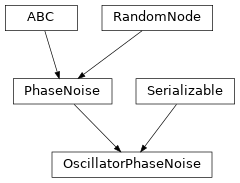Oscillator Phase Noise¶

Oscillator phase noise model according to Khanzadi et al.[1], modeling the phase noise of an oscillator as a function of the distance to the carrier frequency \(\Delta f\) in frequency domain. Phase noise is modeled as a superposition of three noise power spectral densities (PSDs)
where
denotes the white noise floor PSD of power \(K_0\),
denotes the flicker noise PSD of power \(K_2\) following a square law decay with distance to the carrier frequency \(\Delta f\) and
denotes the flicker noise PSD of power \(K_3\) following a cubic law decay with distance to the carrier frequency \(\Delta f\). A starting point for the parameter values is given by Khanzadi et al.[1] as
- class OscillatorPhaseNoise(K0=1e-11, K2=10, K3=10000, seed=None)[source]¶
Bases:
PhaseNoise,SerializableOscillator phase noise model defined in frequency domain.
Refer to Khanzadi et al.[1] for addtional information.
- Parameters:
- add_noise(signal)[source]¶
Add phase noise to a signal model.
- Parameters:
signal (Signal) – The signal model to which phase noise is to be added.
- Return type:
Returns: Noise signal model.
- property K0: float¶
White noise floor power level, denoted as \(K_0\).
- Raises:
ValueError – If the value is negative.
- property K2: float¶
Power level of the 2nd order flicker noise component, denoted as \(K_2\).
- Raises:
ValueError – If the value is negative.
- property K3: float¶
Power level of the 3rd order flicker noise component, denoted as \(K_3\).
- Raises:
ValueError – If the value is negative.